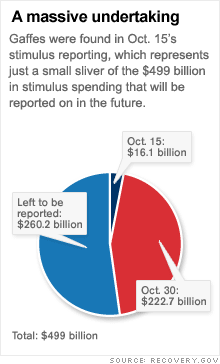Why stimulus jobs aren't here to stay
One company was able to hire thousands of call-center employees for digital TV transition. The temporary nature of those jobs underscores questions about stimulus job creation.

NEW YORK (CNNMoney.com) -- Stimulus may have created or saved 640,000 jobs so far, but many of those positions were never intended to last.
The American Recovery and Reinvestment Act was designed to put millions of people to work, mainly for "shovel-ready" projects. By their very nature, most of those projects last only until the work is completed or the funding runs out.
That means millions of workers hired with stimulus funding are left looking for a job after the stimulus-funded program is completed.
Of the nearly $500 billion in stimulus funds allocated to stimulus projects, $100 billion is set to go towards long-term programs, like health research and green energy projects, according Elizabeth Oxhorn, spokeswoman for the Obama administration Recovery Act. But the vast majority of that funding -- the other $400 billion -- will go to short-term contracts.
A prime example was the work needed by the Federal Communications Commission to help the nation transition to digital television last spring. Congress allowed the FCC to extend the deadline for the transition by five months to help some 3 million people make the switch.
An FCC spokeswoman said there were hundreds of thousands of consumers' calls coming in as the original deadline approached, overwhelming their in-house call center. The agency decided to outsource its call center for the second go-around and awarded a stimulus-funded contract to TeleTech (TTEC), a call-center company based out of Englewood, Colo.
Over the course of the five-month contract, TeleTech hired and trained 4,231 people in call centers across nine states. More than 1.2 million consumer calls were handled by those workers in centers in Arizona, Alabama, California, Colorado, Florida, Kentucky, New York, Pennsylvania, and West Virginia.
TeleTech ramped up its hiring as the June deadline approached, so most of those 4,231 jobs lasted for just a month or less, said TeleTech spokesman Bob Livingstone. The company began winding down the call-centers after June, and when the contract ended in August, all of the jobs that TeleTech created were terminated.
Livingstone said all of the temporary employees who were hired for the DTV contract were eligible for rehire at TeleTech, and a small handful remain with the company after applying for work on other projects. Because the jobs were so spread out geographically, Livingstone said the company was unable to determine which current employees had actually worked on the DTV contract.
Though none of those stimulus-created jobs exist anymore, TeleTech reported that it had created 635 full-time jobs -- a number it reached based on a government formula for reporting stimulus jobs creation. The formula calculates the economic impact of jobs saved or created based on hours worked at an annualized rate. A spokeswoman for the FCC confirmed that the number was reported correctly.
Stop-gap or big bet? The DTV stimulus jobs example underscores the difficulty in both reporting the number of jobs created and the ability to create long-lasting, high-impact jobs during an economic downturn.
Economists say that a majority of the jobs created by stimulus projects are likely to end the same way that the DTV call center positions did, lasting only as long as the funding.
"The bottom line is these are meant to be stop-gap measures," said Doug Roberts, chief investment strategist at ChannelCapitalResearch.com. "This is fairly typical in stimulus plans. It's the same as it was in the 1930s: to put people back to work, the government looks at all of the stuff that was on its to-do list."
Roberts said the idea behind temporary, "shovel-ready" stimulus jobs, is to help the labor market ride out the storm: When the money runs out, hopefully the economy will have bounced back, and those temporary workers will be able to find full-time employment.
But others say the economy won't be healthy enough to support job growth when stimulus funding runs out, and most businesses have indicated that they will not be hiring in the coming quarters.
"Unless they pass another stimulus bill, you'll get an economic uptick, but not much job growth, and then another downturn," said Al Angrisani, head of hiring consultancy Angrisani Turnarounds and former assistant secretary of labor under President Reagan. "Hoping that jobs will be there when the money runs out is like betting on animal spirits. The businesses that they're betting on are all deleveraging."
Do you have a job because of the $787 billion stimulus package? We want to hear from people whose jobs have been created or saved by the American Recovery and Reinvestment Act. Please e-mail your stories to CNNMoney.com and you could be part of an upcoming article. For the CNNMoney.com Comment Policy, click here. ![]()


